Analyzing Working Capital's Impact on Retail Firm Profitability
VerifiedAdded on 2023/01/18
|57
|17565
|1
Project
AI Summary
This project is a comprehensive analysis of the impact of working capital management (WCM) on the profitability of retail sector firms, focusing on Tesco, Morrisons, Sainsbury's, and ASDA. It begins with an introduction to working capital, its components, and the importance of effective management. The study aims to identify the relationship between WCM and profitability, and to assess the impact of different factors of working capital on company performance. The literature review explores existing research on WCM theories and models. The methodology section outlines the research approach, data collection, and analysis techniques. Data analysis and findings are presented, followed by conclusions and recommendations for improving WCM strategies within the retail sector. The project uses a quantitative approach, examining financial data and ratios to draw conclusions about the effects of WCM on firm profitability. The project also provides strategies for improving the working capital.
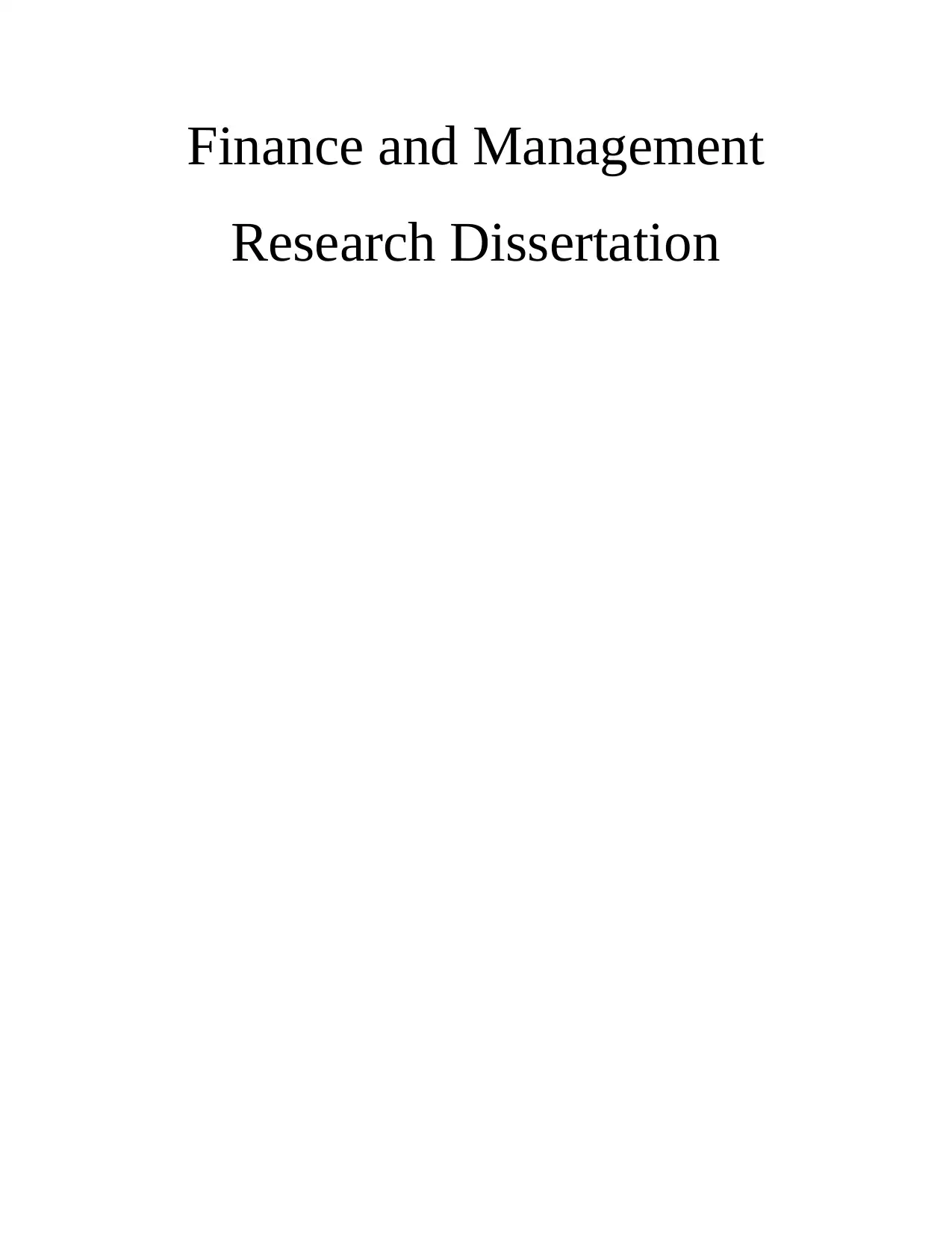
Finance and Management
Research Dissertation
Research Dissertation
Paraphrase This Document
Need a fresh take? Get an instant paraphrase of this document with our AI Paraphraser
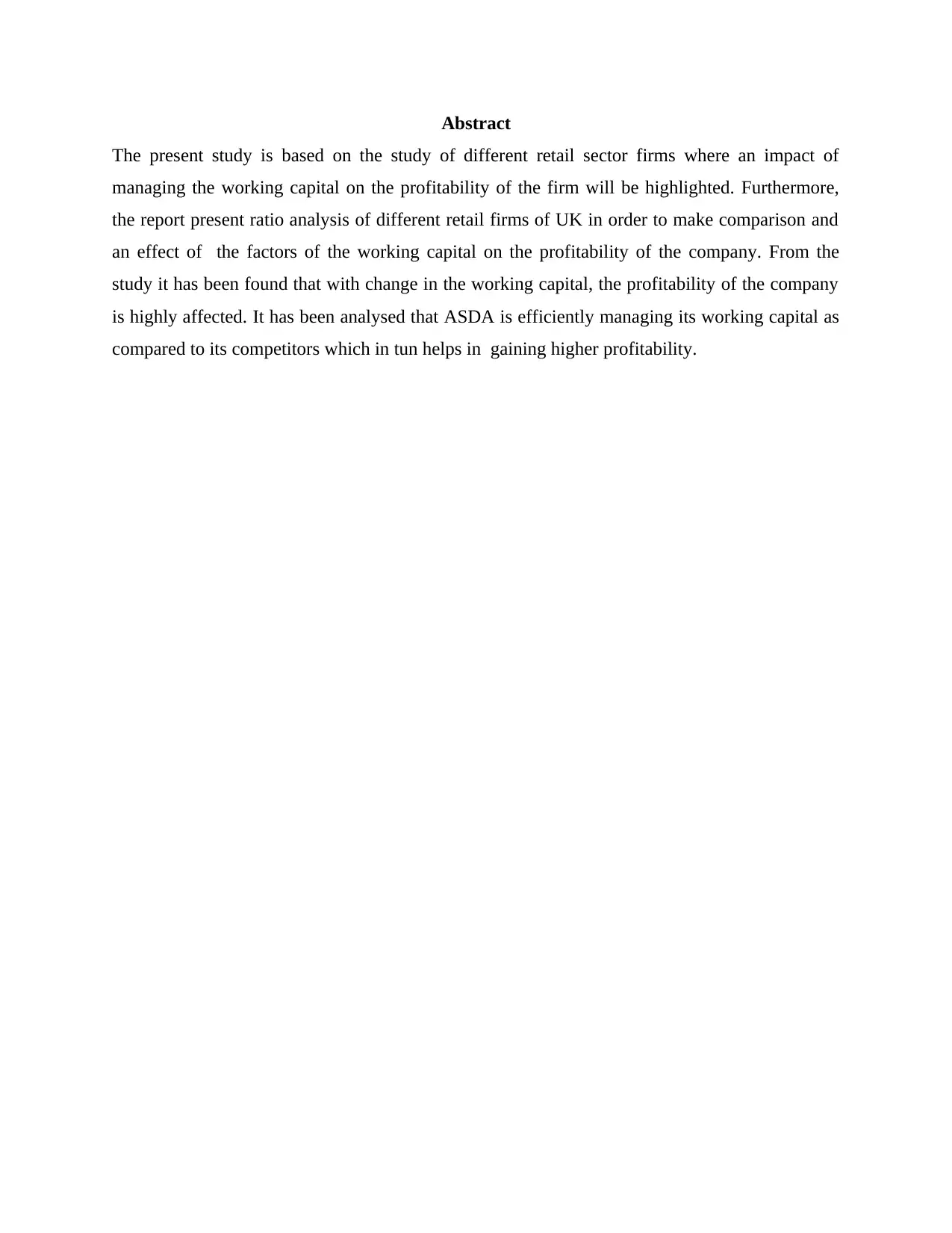
Abstract
The present study is based on the study of different retail sector firms where an impact of
managing the working capital on the profitability of the firm will be highlighted. Furthermore,
the report present ratio analysis of different retail firms of UK in order to make comparison and
an effect of the factors of the working capital on the profitability of the company. From the
study it has been found that with change in the working capital, the profitability of the company
is highly affected. It has been analysed that ASDA is efficiently managing its working capital as
compared to its competitors which in tun helps in gaining higher profitability.
The present study is based on the study of different retail sector firms where an impact of
managing the working capital on the profitability of the firm will be highlighted. Furthermore,
the report present ratio analysis of different retail firms of UK in order to make comparison and
an effect of the factors of the working capital on the profitability of the company. From the
study it has been found that with change in the working capital, the profitability of the company
is highly affected. It has been analysed that ASDA is efficiently managing its working capital as
compared to its competitors which in tun helps in gaining higher profitability.
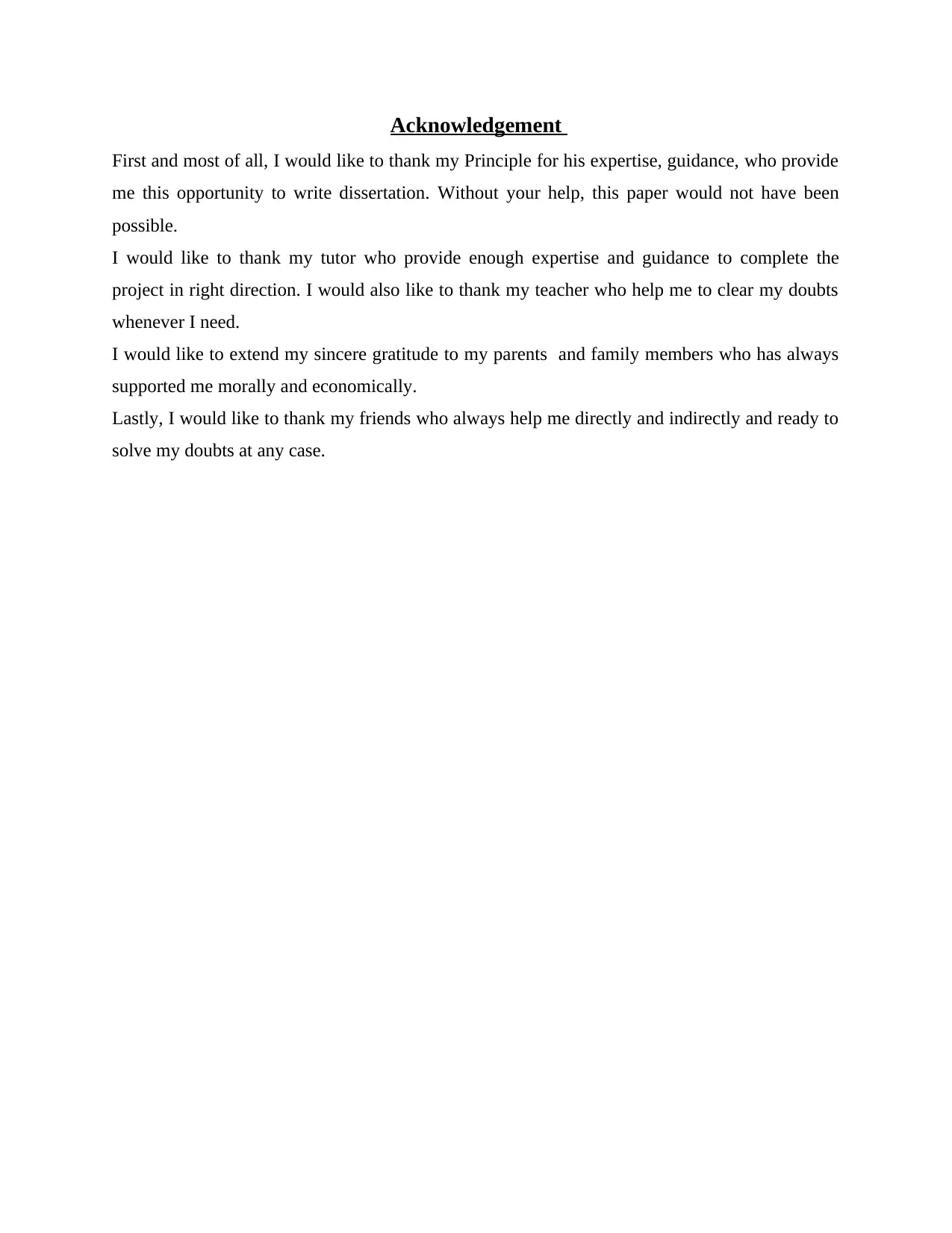
Acknowledgement
First and most of all, I would like to thank my Principle for his expertise, guidance, who provide
me this opportunity to write dissertation. Without your help, this paper would not have been
possible.
I would like to thank my tutor who provide enough expertise and guidance to complete the
project in right direction. I would also like to thank my teacher who help me to clear my doubts
whenever I need.
I would like to extend my sincere gratitude to my parents and family members who has always
supported me morally and economically.
Lastly, I would like to thank my friends who always help me directly and indirectly and ready to
solve my doubts at any case.
First and most of all, I would like to thank my Principle for his expertise, guidance, who provide
me this opportunity to write dissertation. Without your help, this paper would not have been
possible.
I would like to thank my tutor who provide enough expertise and guidance to complete the
project in right direction. I would also like to thank my teacher who help me to clear my doubts
whenever I need.
I would like to extend my sincere gratitude to my parents and family members who has always
supported me morally and economically.
Lastly, I would like to thank my friends who always help me directly and indirectly and ready to
solve my doubts at any case.
⊘ This is a preview!⊘
Do you want full access?
Subscribe today to unlock all pages.

Trusted by 1+ million students worldwide
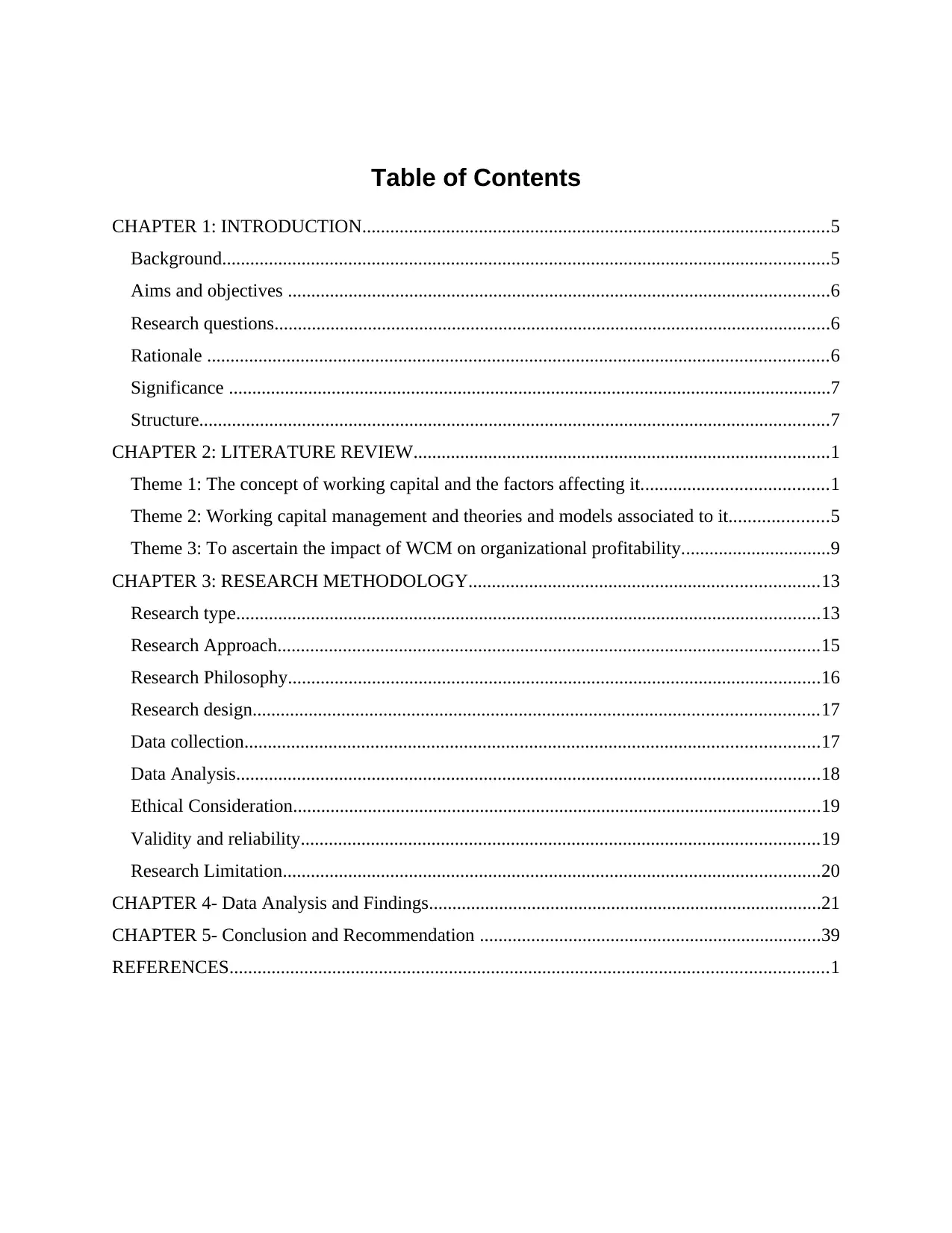
Table of Contents
CHAPTER 1: INTRODUCTION....................................................................................................5
Background..................................................................................................................................5
Aims and objectives ....................................................................................................................6
Research questions.......................................................................................................................6
Rationale .....................................................................................................................................6
Significance .................................................................................................................................7
Structure.......................................................................................................................................7
CHAPTER 2: LITERATURE REVIEW.........................................................................................1
Theme 1: The concept of working capital and the factors affecting it........................................1
Theme 2: Working capital management and theories and models associated to it.....................5
Theme 3: To ascertain the impact of WCM on organizational profitability................................9
CHAPTER 3: RESEARCH METHODOLOGY...........................................................................13
Research type.............................................................................................................................13
Research Approach....................................................................................................................15
Research Philosophy..................................................................................................................16
Research design.........................................................................................................................17
Data collection...........................................................................................................................17
Data Analysis.............................................................................................................................18
Ethical Consideration.................................................................................................................19
Validity and reliability...............................................................................................................19
Research Limitation...................................................................................................................20
CHAPTER 4- Data Analysis and Findings....................................................................................21
CHAPTER 5- Conclusion and Recommendation .........................................................................39
REFERENCES................................................................................................................................1
CHAPTER 1: INTRODUCTION....................................................................................................5
Background..................................................................................................................................5
Aims and objectives ....................................................................................................................6
Research questions.......................................................................................................................6
Rationale .....................................................................................................................................6
Significance .................................................................................................................................7
Structure.......................................................................................................................................7
CHAPTER 2: LITERATURE REVIEW.........................................................................................1
Theme 1: The concept of working capital and the factors affecting it........................................1
Theme 2: Working capital management and theories and models associated to it.....................5
Theme 3: To ascertain the impact of WCM on organizational profitability................................9
CHAPTER 3: RESEARCH METHODOLOGY...........................................................................13
Research type.............................................................................................................................13
Research Approach....................................................................................................................15
Research Philosophy..................................................................................................................16
Research design.........................................................................................................................17
Data collection...........................................................................................................................17
Data Analysis.............................................................................................................................18
Ethical Consideration.................................................................................................................19
Validity and reliability...............................................................................................................19
Research Limitation...................................................................................................................20
CHAPTER 4- Data Analysis and Findings....................................................................................21
CHAPTER 5- Conclusion and Recommendation .........................................................................39
REFERENCES................................................................................................................................1
Paraphrase This Document
Need a fresh take? Get an instant paraphrase of this document with our AI Paraphraser
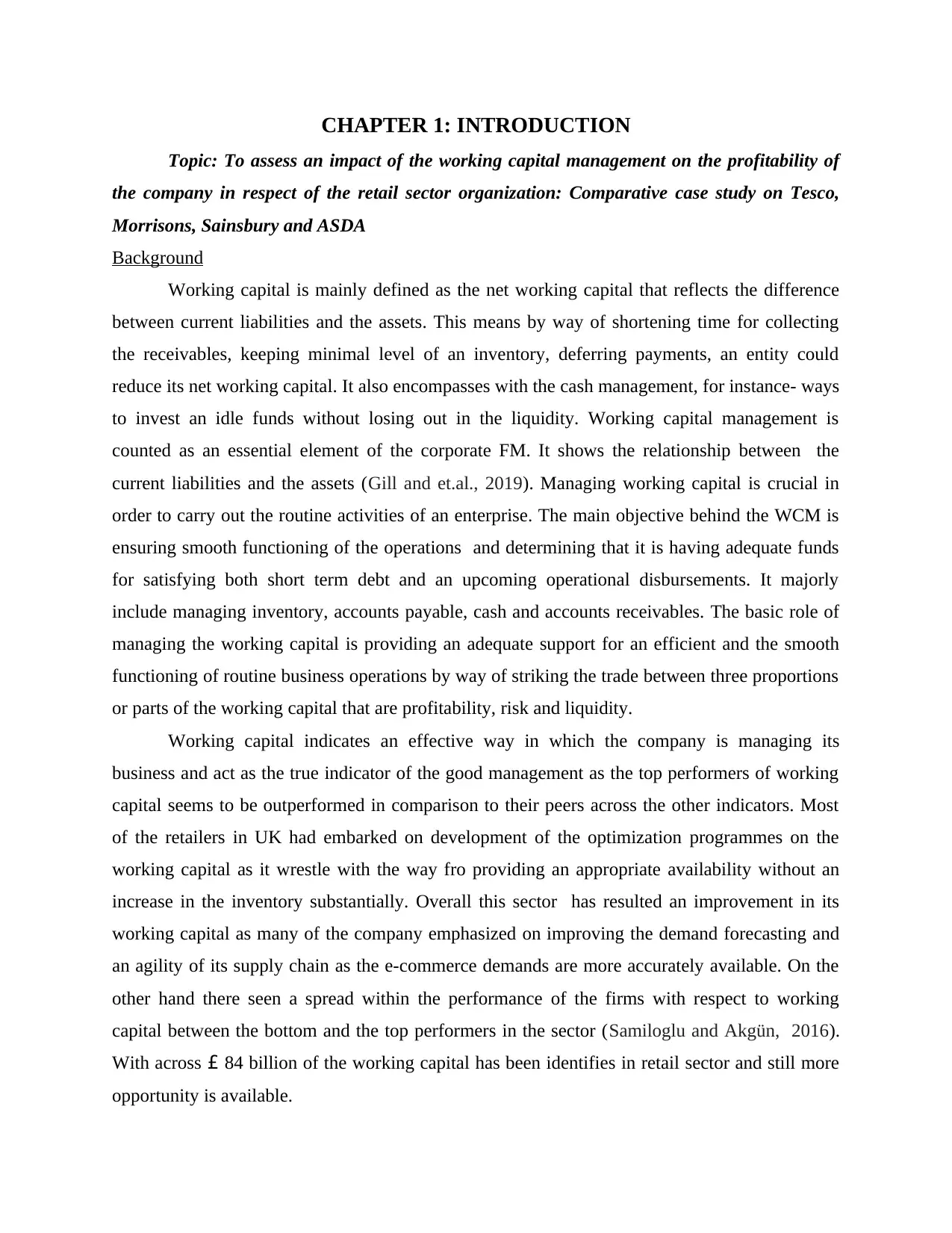
CHAPTER 1: INTRODUCTION
Topic: To assess an impact of the working capital management on the profitability of
the company in respect of the retail sector organization: Comparative case study on Tesco,
Morrisons, Sainsbury and ASDA
Background
Working capital is mainly defined as the net working capital that reflects the difference
between current liabilities and the assets. This means by way of shortening time for collecting
the receivables, keeping minimal level of an inventory, deferring payments, an entity could
reduce its net working capital. It also encompasses with the cash management, for instance- ways
to invest an idle funds without losing out in the liquidity. Working capital management is
counted as an essential element of the corporate FM. It shows the relationship between the
current liabilities and the assets (Gill and et.al., 2019). Managing working capital is crucial in
order to carry out the routine activities of an enterprise. The main objective behind the WCM is
ensuring smooth functioning of the operations and determining that it is having adequate funds
for satisfying both short term debt and an upcoming operational disbursements. It majorly
include managing inventory, accounts payable, cash and accounts receivables. The basic role of
managing the working capital is providing an adequate support for an efficient and the smooth
functioning of routine business operations by way of striking the trade between three proportions
or parts of the working capital that are profitability, risk and liquidity.
Working capital indicates an effective way in which the company is managing its
business and act as the true indicator of the good management as the top performers of working
capital seems to be outperformed in comparison to their peers across the other indicators. Most
of the retailers in UK had embarked on development of the optimization programmes on the
working capital as it wrestle with the way fro providing an appropriate availability without an
increase in the inventory substantially. Overall this sector has resulted an improvement in its
working capital as many of the company emphasized on improving the demand forecasting and
an agility of its supply chain as the e-commerce demands are more accurately available. On the
other hand there seen a spread within the performance of the firms with respect to working
capital between the bottom and the top performers in the sector (Samiloglu and Akgün, 2016).
With across £ 84 billion of the working capital has been identifies in retail sector and still more
opportunity is available.
Topic: To assess an impact of the working capital management on the profitability of
the company in respect of the retail sector organization: Comparative case study on Tesco,
Morrisons, Sainsbury and ASDA
Background
Working capital is mainly defined as the net working capital that reflects the difference
between current liabilities and the assets. This means by way of shortening time for collecting
the receivables, keeping minimal level of an inventory, deferring payments, an entity could
reduce its net working capital. It also encompasses with the cash management, for instance- ways
to invest an idle funds without losing out in the liquidity. Working capital management is
counted as an essential element of the corporate FM. It shows the relationship between the
current liabilities and the assets (Gill and et.al., 2019). Managing working capital is crucial in
order to carry out the routine activities of an enterprise. The main objective behind the WCM is
ensuring smooth functioning of the operations and determining that it is having adequate funds
for satisfying both short term debt and an upcoming operational disbursements. It majorly
include managing inventory, accounts payable, cash and accounts receivables. The basic role of
managing the working capital is providing an adequate support for an efficient and the smooth
functioning of routine business operations by way of striking the trade between three proportions
or parts of the working capital that are profitability, risk and liquidity.
Working capital indicates an effective way in which the company is managing its
business and act as the true indicator of the good management as the top performers of working
capital seems to be outperformed in comparison to their peers across the other indicators. Most
of the retailers in UK had embarked on development of the optimization programmes on the
working capital as it wrestle with the way fro providing an appropriate availability without an
increase in the inventory substantially. Overall this sector has resulted an improvement in its
working capital as many of the company emphasized on improving the demand forecasting and
an agility of its supply chain as the e-commerce demands are more accurately available. On the
other hand there seen a spread within the performance of the firms with respect to working
capital between the bottom and the top performers in the sector (Samiloglu and Akgün, 2016).
With across £ 84 billion of the working capital has been identifies in retail sector and still more
opportunity is available.
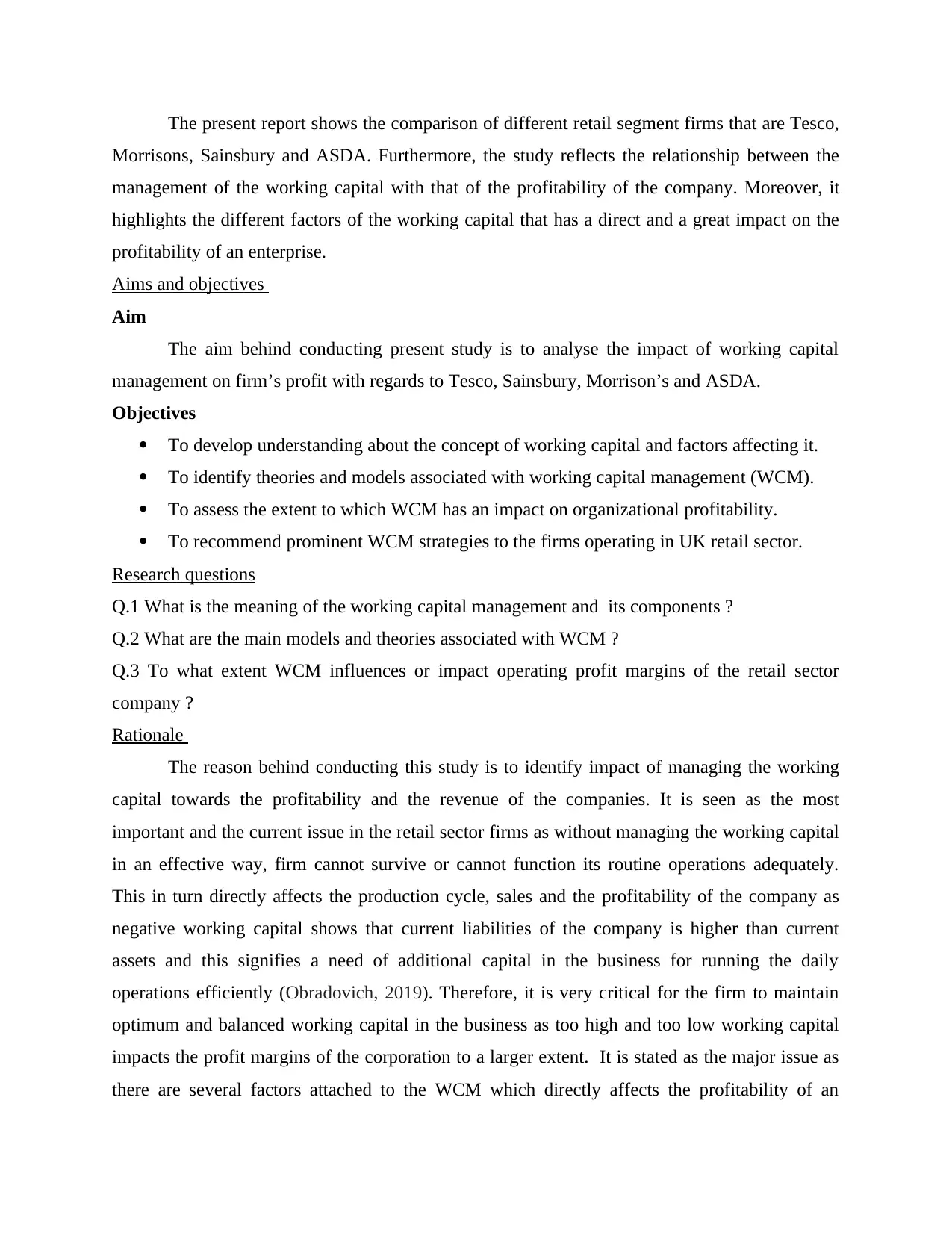
The present report shows the comparison of different retail segment firms that are Tesco,
Morrisons, Sainsbury and ASDA. Furthermore, the study reflects the relationship between the
management of the working capital with that of the profitability of the company. Moreover, it
highlights the different factors of the working capital that has a direct and a great impact on the
profitability of an enterprise.
Aims and objectives
Aim
The aim behind conducting present study is to analyse the impact of working capital
management on firm’s profit with regards to Tesco, Sainsbury, Morrison’s and ASDA.
Objectives
To develop understanding about the concept of working capital and factors affecting it.
To identify theories and models associated with working capital management (WCM).
To assess the extent to which WCM has an impact on organizational profitability.
To recommend prominent WCM strategies to the firms operating in UK retail sector.
Research questions
Q.1 What is the meaning of the working capital management and its components ?
Q.2 What are the main models and theories associated with WCM ?
Q.3 To what extent WCM influences or impact operating profit margins of the retail sector
company ?
Rationale
The reason behind conducting this study is to identify impact of managing the working
capital towards the profitability and the revenue of the companies. It is seen as the most
important and the current issue in the retail sector firms as without managing the working capital
in an effective way, firm cannot survive or cannot function its routine operations adequately.
This in turn directly affects the production cycle, sales and the profitability of the company as
negative working capital shows that current liabilities of the company is higher than current
assets and this signifies a need of additional capital in the business for running the daily
operations efficiently (Obradovich, 2019). Therefore, it is very critical for the firm to maintain
optimum and balanced working capital in the business as too high and too low working capital
impacts the profit margins of the corporation to a larger extent. It is stated as the major issue as
there are several factors attached to the WCM which directly affects the profitability of an
Morrisons, Sainsbury and ASDA. Furthermore, the study reflects the relationship between the
management of the working capital with that of the profitability of the company. Moreover, it
highlights the different factors of the working capital that has a direct and a great impact on the
profitability of an enterprise.
Aims and objectives
Aim
The aim behind conducting present study is to analyse the impact of working capital
management on firm’s profit with regards to Tesco, Sainsbury, Morrison’s and ASDA.
Objectives
To develop understanding about the concept of working capital and factors affecting it.
To identify theories and models associated with working capital management (WCM).
To assess the extent to which WCM has an impact on organizational profitability.
To recommend prominent WCM strategies to the firms operating in UK retail sector.
Research questions
Q.1 What is the meaning of the working capital management and its components ?
Q.2 What are the main models and theories associated with WCM ?
Q.3 To what extent WCM influences or impact operating profit margins of the retail sector
company ?
Rationale
The reason behind conducting this study is to identify impact of managing the working
capital towards the profitability and the revenue of the companies. It is seen as the most
important and the current issue in the retail sector firms as without managing the working capital
in an effective way, firm cannot survive or cannot function its routine operations adequately.
This in turn directly affects the production cycle, sales and the profitability of the company as
negative working capital shows that current liabilities of the company is higher than current
assets and this signifies a need of additional capital in the business for running the daily
operations efficiently (Obradovich, 2019). Therefore, it is very critical for the firm to maintain
optimum and balanced working capital in the business as too high and too low working capital
impacts the profit margins of the corporation to a larger extent. It is stated as the major issue as
there are several factors attached to the WCM which directly affects the profitability of an
⊘ This is a preview!⊘
Do you want full access?
Subscribe today to unlock all pages.

Trusted by 1+ million students worldwide
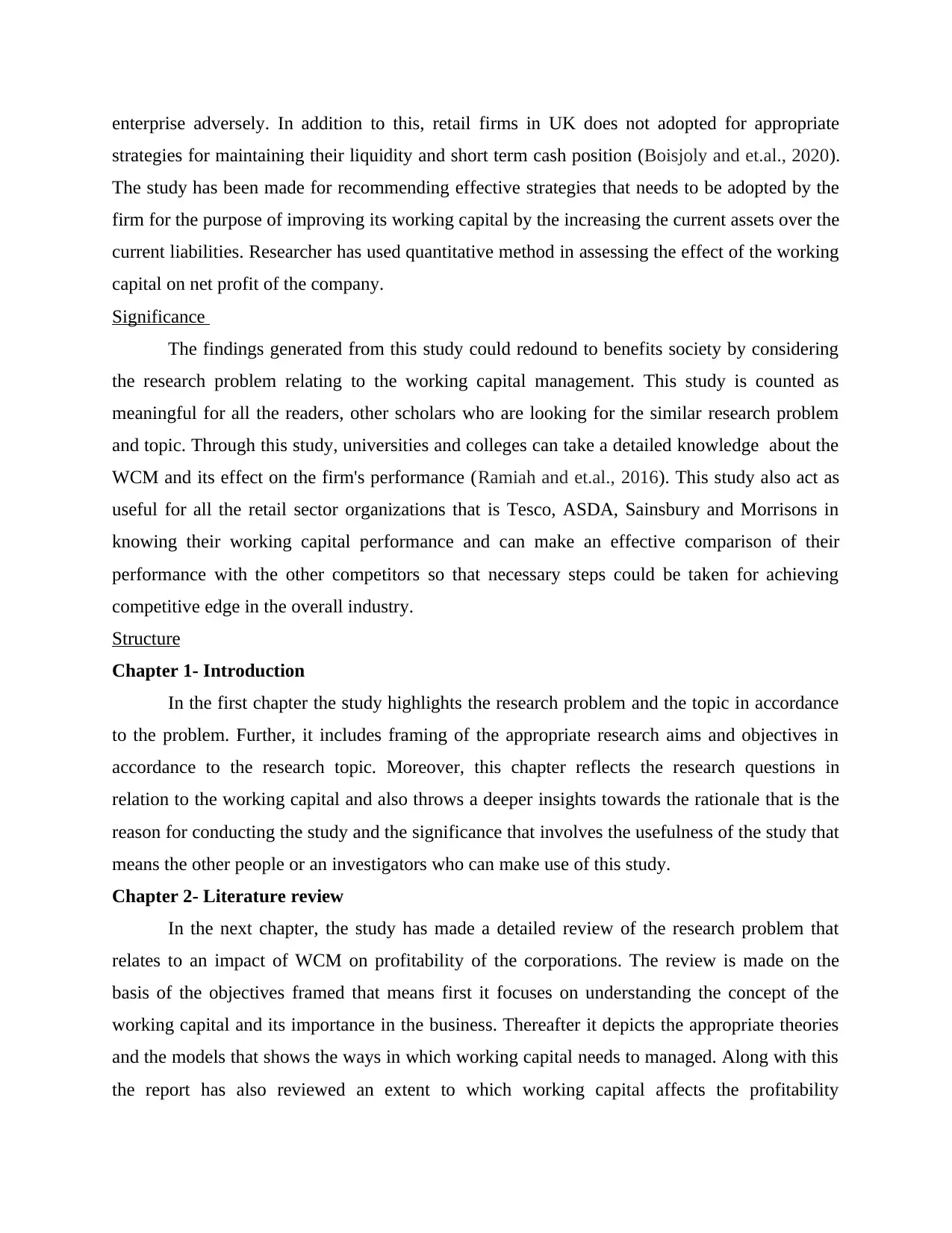
enterprise adversely. In addition to this, retail firms in UK does not adopted for appropriate
strategies for maintaining their liquidity and short term cash position (Boisjoly and et.al., 2020).
The study has been made for recommending effective strategies that needs to be adopted by the
firm for the purpose of improving its working capital by the increasing the current assets over the
current liabilities. Researcher has used quantitative method in assessing the effect of the working
capital on net profit of the company.
Significance
The findings generated from this study could redound to benefits society by considering
the research problem relating to the working capital management. This study is counted as
meaningful for all the readers, other scholars who are looking for the similar research problem
and topic. Through this study, universities and colleges can take a detailed knowledge about the
WCM and its effect on the firm's performance (Ramiah and et.al., 2016). This study also act as
useful for all the retail sector organizations that is Tesco, ASDA, Sainsbury and Morrisons in
knowing their working capital performance and can make an effective comparison of their
performance with the other competitors so that necessary steps could be taken for achieving
competitive edge in the overall industry.
Structure
Chapter 1- Introduction
In the first chapter the study highlights the research problem and the topic in accordance
to the problem. Further, it includes framing of the appropriate research aims and objectives in
accordance to the research topic. Moreover, this chapter reflects the research questions in
relation to the working capital and also throws a deeper insights towards the rationale that is the
reason for conducting the study and the significance that involves the usefulness of the study that
means the other people or an investigators who can make use of this study.
Chapter 2- Literature review
In the next chapter, the study has made a detailed review of the research problem that
relates to an impact of WCM on profitability of the corporations. The review is made on the
basis of the objectives framed that means first it focuses on understanding the concept of the
working capital and its importance in the business. Thereafter it depicts the appropriate theories
and the models that shows the ways in which working capital needs to managed. Along with this
the report has also reviewed an extent to which working capital affects the profitability
strategies for maintaining their liquidity and short term cash position (Boisjoly and et.al., 2020).
The study has been made for recommending effective strategies that needs to be adopted by the
firm for the purpose of improving its working capital by the increasing the current assets over the
current liabilities. Researcher has used quantitative method in assessing the effect of the working
capital on net profit of the company.
Significance
The findings generated from this study could redound to benefits society by considering
the research problem relating to the working capital management. This study is counted as
meaningful for all the readers, other scholars who are looking for the similar research problem
and topic. Through this study, universities and colleges can take a detailed knowledge about the
WCM and its effect on the firm's performance (Ramiah and et.al., 2016). This study also act as
useful for all the retail sector organizations that is Tesco, ASDA, Sainsbury and Morrisons in
knowing their working capital performance and can make an effective comparison of their
performance with the other competitors so that necessary steps could be taken for achieving
competitive edge in the overall industry.
Structure
Chapter 1- Introduction
In the first chapter the study highlights the research problem and the topic in accordance
to the problem. Further, it includes framing of the appropriate research aims and objectives in
accordance to the research topic. Moreover, this chapter reflects the research questions in
relation to the working capital and also throws a deeper insights towards the rationale that is the
reason for conducting the study and the significance that involves the usefulness of the study that
means the other people or an investigators who can make use of this study.
Chapter 2- Literature review
In the next chapter, the study has made a detailed review of the research problem that
relates to an impact of WCM on profitability of the corporations. The review is made on the
basis of the objectives framed that means first it focuses on understanding the concept of the
working capital and its importance in the business. Thereafter it depicts the appropriate theories
and the models that shows the ways in which working capital needs to managed. Along with this
the report has also reviewed an extent to which working capital affects the profitability
Paraphrase This Document
Need a fresh take? Get an instant paraphrase of this document with our AI Paraphraser
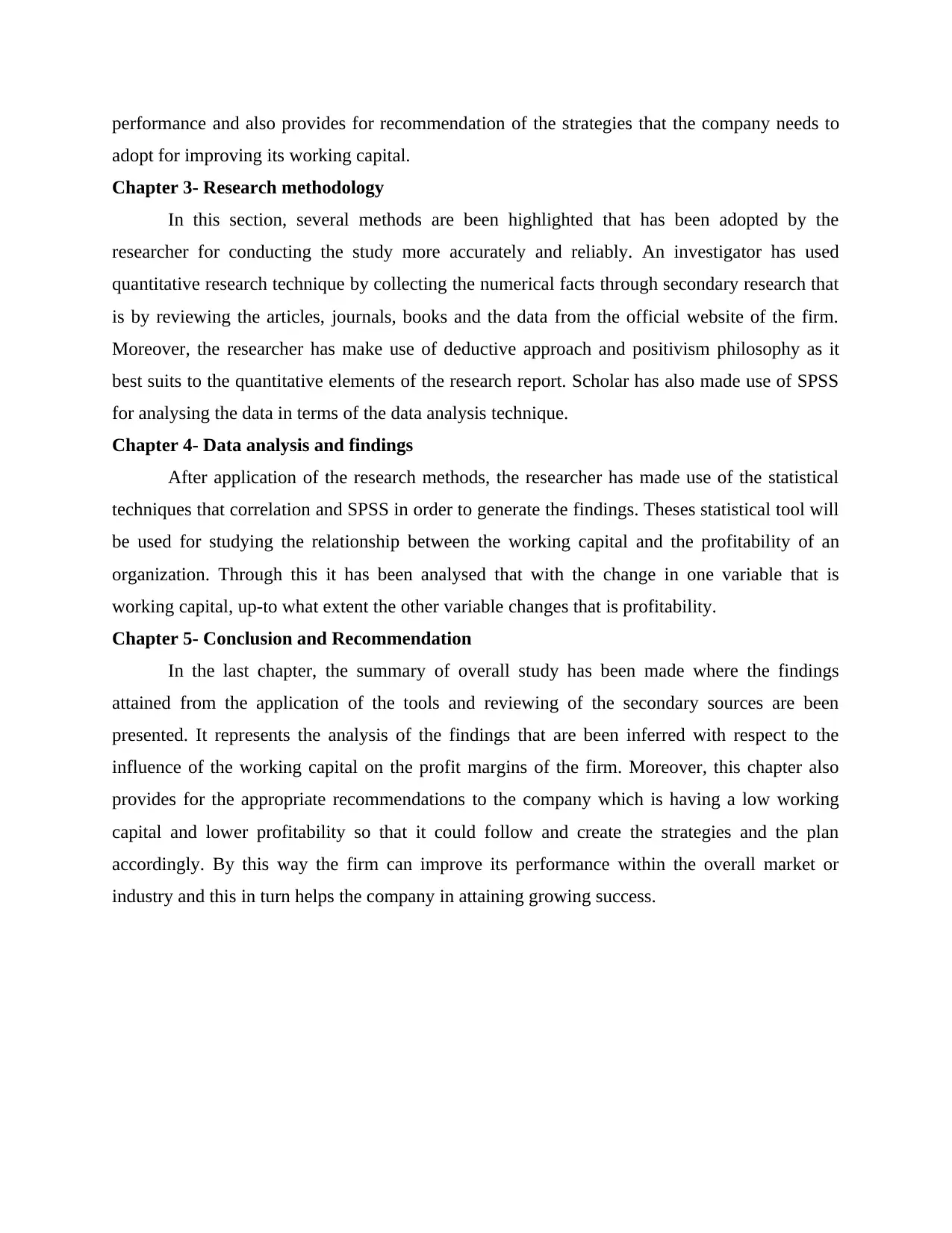
performance and also provides for recommendation of the strategies that the company needs to
adopt for improving its working capital.
Chapter 3- Research methodology
In this section, several methods are been highlighted that has been adopted by the
researcher for conducting the study more accurately and reliably. An investigator has used
quantitative research technique by collecting the numerical facts through secondary research that
is by reviewing the articles, journals, books and the data from the official website of the firm.
Moreover, the researcher has make use of deductive approach and positivism philosophy as it
best suits to the quantitative elements of the research report. Scholar has also made use of SPSS
for analysing the data in terms of the data analysis technique.
Chapter 4- Data analysis and findings
After application of the research methods, the researcher has made use of the statistical
techniques that correlation and SPSS in order to generate the findings. Theses statistical tool will
be used for studying the relationship between the working capital and the profitability of an
organization. Through this it has been analysed that with the change in one variable that is
working capital, up-to what extent the other variable changes that is profitability.
Chapter 5- Conclusion and Recommendation
In the last chapter, the summary of overall study has been made where the findings
attained from the application of the tools and reviewing of the secondary sources are been
presented. It represents the analysis of the findings that are been inferred with respect to the
influence of the working capital on the profit margins of the firm. Moreover, this chapter also
provides for the appropriate recommendations to the company which is having a low working
capital and lower profitability so that it could follow and create the strategies and the plan
accordingly. By this way the firm can improve its performance within the overall market or
industry and this in turn helps the company in attaining growing success.
adopt for improving its working capital.
Chapter 3- Research methodology
In this section, several methods are been highlighted that has been adopted by the
researcher for conducting the study more accurately and reliably. An investigator has used
quantitative research technique by collecting the numerical facts through secondary research that
is by reviewing the articles, journals, books and the data from the official website of the firm.
Moreover, the researcher has make use of deductive approach and positivism philosophy as it
best suits to the quantitative elements of the research report. Scholar has also made use of SPSS
for analysing the data in terms of the data analysis technique.
Chapter 4- Data analysis and findings
After application of the research methods, the researcher has made use of the statistical
techniques that correlation and SPSS in order to generate the findings. Theses statistical tool will
be used for studying the relationship between the working capital and the profitability of an
organization. Through this it has been analysed that with the change in one variable that is
working capital, up-to what extent the other variable changes that is profitability.
Chapter 5- Conclusion and Recommendation
In the last chapter, the summary of overall study has been made where the findings
attained from the application of the tools and reviewing of the secondary sources are been
presented. It represents the analysis of the findings that are been inferred with respect to the
influence of the working capital on the profit margins of the firm. Moreover, this chapter also
provides for the appropriate recommendations to the company which is having a low working
capital and lower profitability so that it could follow and create the strategies and the plan
accordingly. By this way the firm can improve its performance within the overall market or
industry and this in turn helps the company in attaining growing success.
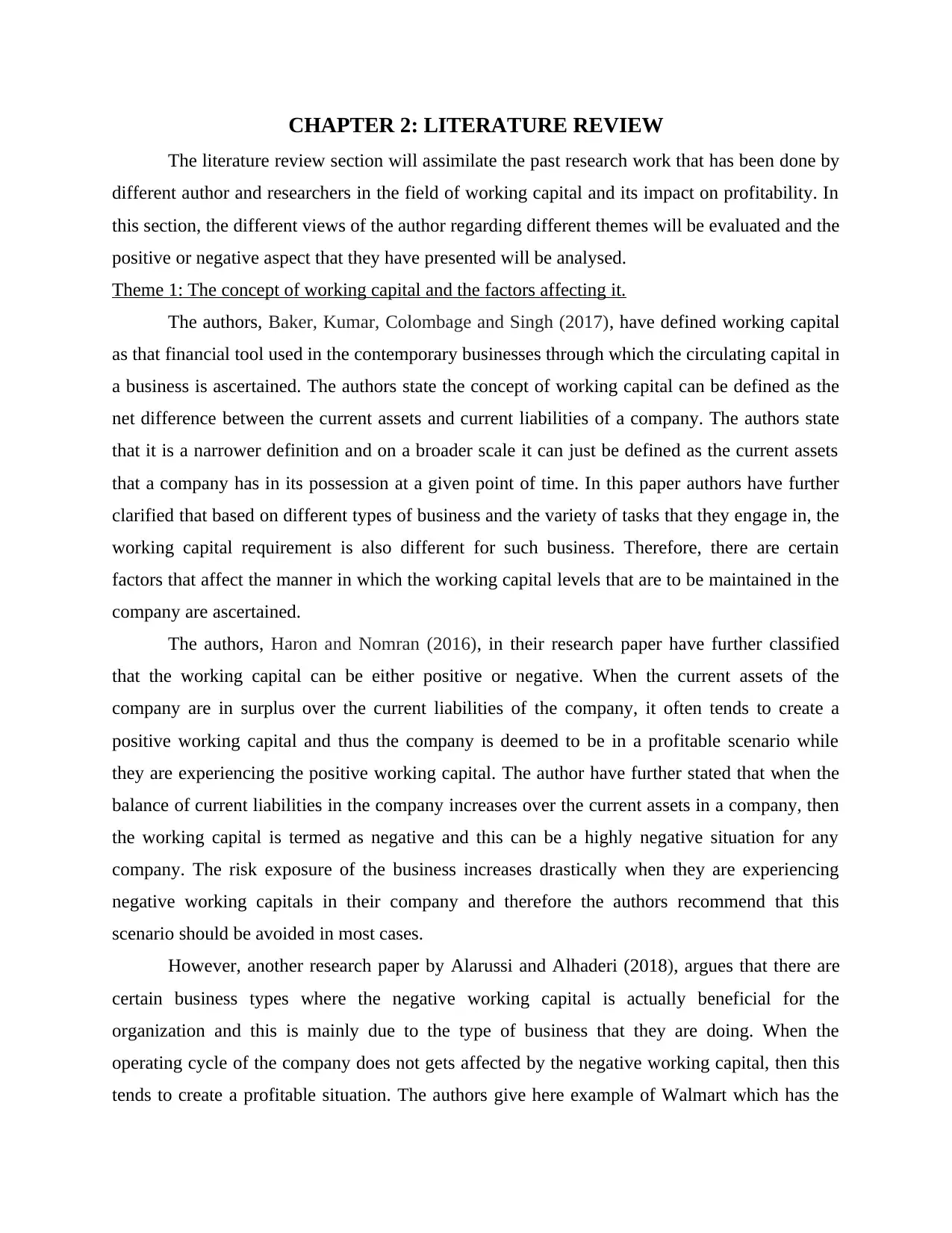
CHAPTER 2: LITERATURE REVIEW
The literature review section will assimilate the past research work that has been done by
different author and researchers in the field of working capital and its impact on profitability. In
this section, the different views of the author regarding different themes will be evaluated and the
positive or negative aspect that they have presented will be analysed.
Theme 1: The concept of working capital and the factors affecting it.
The authors, Baker, Kumar, Colombage and Singh (2017), have defined working capital
as that financial tool used in the contemporary businesses through which the circulating capital in
a business is ascertained. The authors state the concept of working capital can be defined as the
net difference between the current assets and current liabilities of a company. The authors state
that it is a narrower definition and on a broader scale it can just be defined as the current assets
that a company has in its possession at a given point of time. In this paper authors have further
clarified that based on different types of business and the variety of tasks that they engage in, the
working capital requirement is also different for such business. Therefore, there are certain
factors that affect the manner in which the working capital levels that are to be maintained in the
company are ascertained.
The authors, Haron and Nomran (2016), in their research paper have further classified
that the working capital can be either positive or negative. When the current assets of the
company are in surplus over the current liabilities of the company, it often tends to create a
positive working capital and thus the company is deemed to be in a profitable scenario while
they are experiencing the positive working capital. The author have further stated that when the
balance of current liabilities in the company increases over the current assets in a company, then
the working capital is termed as negative and this can be a highly negative situation for any
company. The risk exposure of the business increases drastically when they are experiencing
negative working capitals in their company and therefore the authors recommend that this
scenario should be avoided in most cases.
However, another research paper by Alarussi and Alhaderi (2018), argues that there are
certain business types where the negative working capital is actually beneficial for the
organization and this is mainly due to the type of business that they are doing. When the
operating cycle of the company does not gets affected by the negative working capital, then this
tends to create a profitable situation. The authors give here example of Walmart which has the
The literature review section will assimilate the past research work that has been done by
different author and researchers in the field of working capital and its impact on profitability. In
this section, the different views of the author regarding different themes will be evaluated and the
positive or negative aspect that they have presented will be analysed.
Theme 1: The concept of working capital and the factors affecting it.
The authors, Baker, Kumar, Colombage and Singh (2017), have defined working capital
as that financial tool used in the contemporary businesses through which the circulating capital in
a business is ascertained. The authors state the concept of working capital can be defined as the
net difference between the current assets and current liabilities of a company. The authors state
that it is a narrower definition and on a broader scale it can just be defined as the current assets
that a company has in its possession at a given point of time. In this paper authors have further
clarified that based on different types of business and the variety of tasks that they engage in, the
working capital requirement is also different for such business. Therefore, there are certain
factors that affect the manner in which the working capital levels that are to be maintained in the
company are ascertained.
The authors, Haron and Nomran (2016), in their research paper have further classified
that the working capital can be either positive or negative. When the current assets of the
company are in surplus over the current liabilities of the company, it often tends to create a
positive working capital and thus the company is deemed to be in a profitable scenario while
they are experiencing the positive working capital. The author have further stated that when the
balance of current liabilities in the company increases over the current assets in a company, then
the working capital is termed as negative and this can be a highly negative situation for any
company. The risk exposure of the business increases drastically when they are experiencing
negative working capitals in their company and therefore the authors recommend that this
scenario should be avoided in most cases.
However, another research paper by Alarussi and Alhaderi (2018), argues that there are
certain business types where the negative working capital is actually beneficial for the
organization and this is mainly due to the type of business that they are doing. When the
operating cycle of the company does not gets affected by the negative working capital, then this
tends to create a profitable situation. The authors give here example of Walmart which has the
⊘ This is a preview!⊘
Do you want full access?
Subscribe today to unlock all pages.

Trusted by 1+ million students worldwide
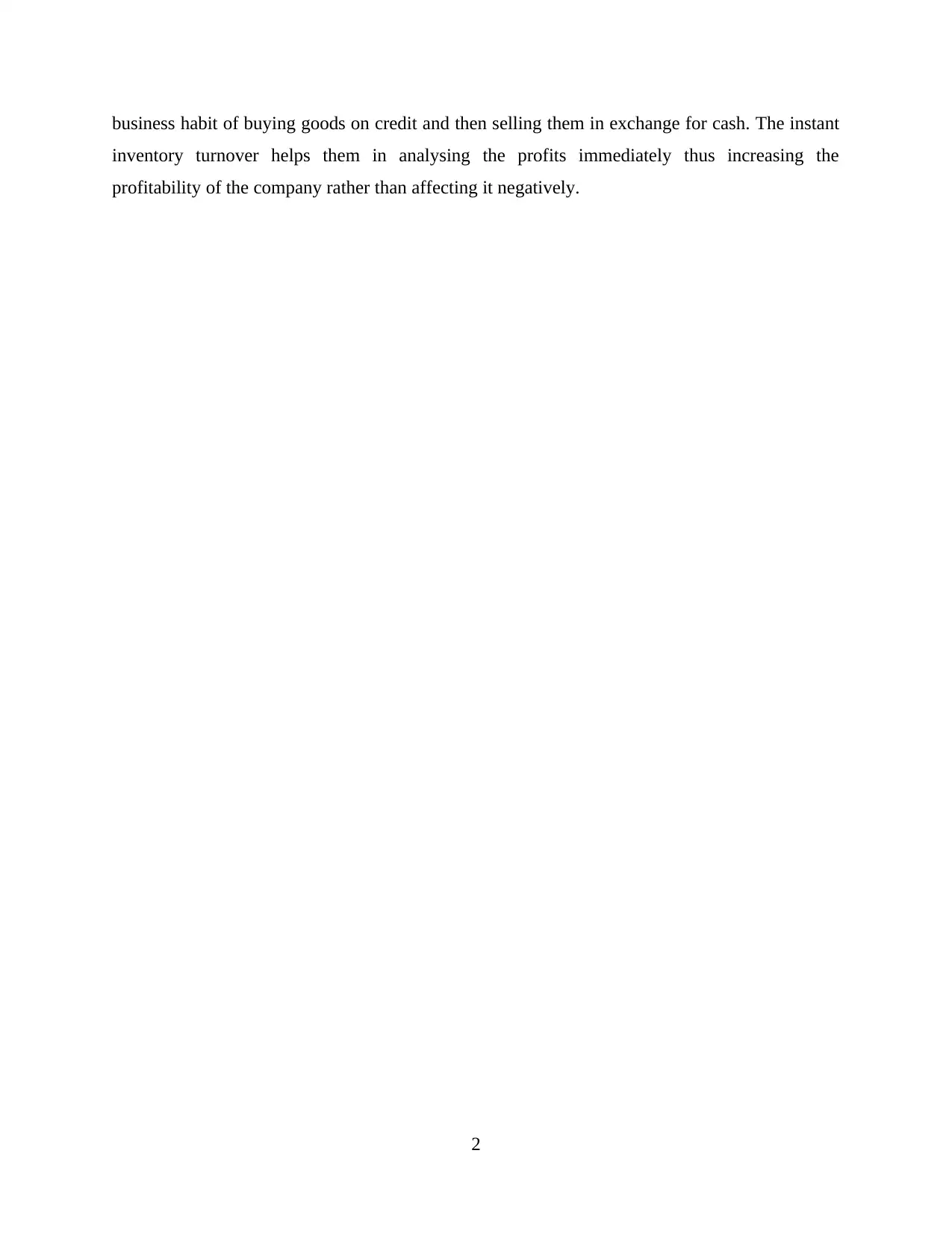
business habit of buying goods on credit and then selling them in exchange for cash. The instant
inventory turnover helps them in analysing the profits immediately thus increasing the
profitability of the company rather than affecting it negatively.
2
inventory turnover helps them in analysing the profits immediately thus increasing the
profitability of the company rather than affecting it negatively.
2
Paraphrase This Document
Need a fresh take? Get an instant paraphrase of this document with our AI Paraphraser
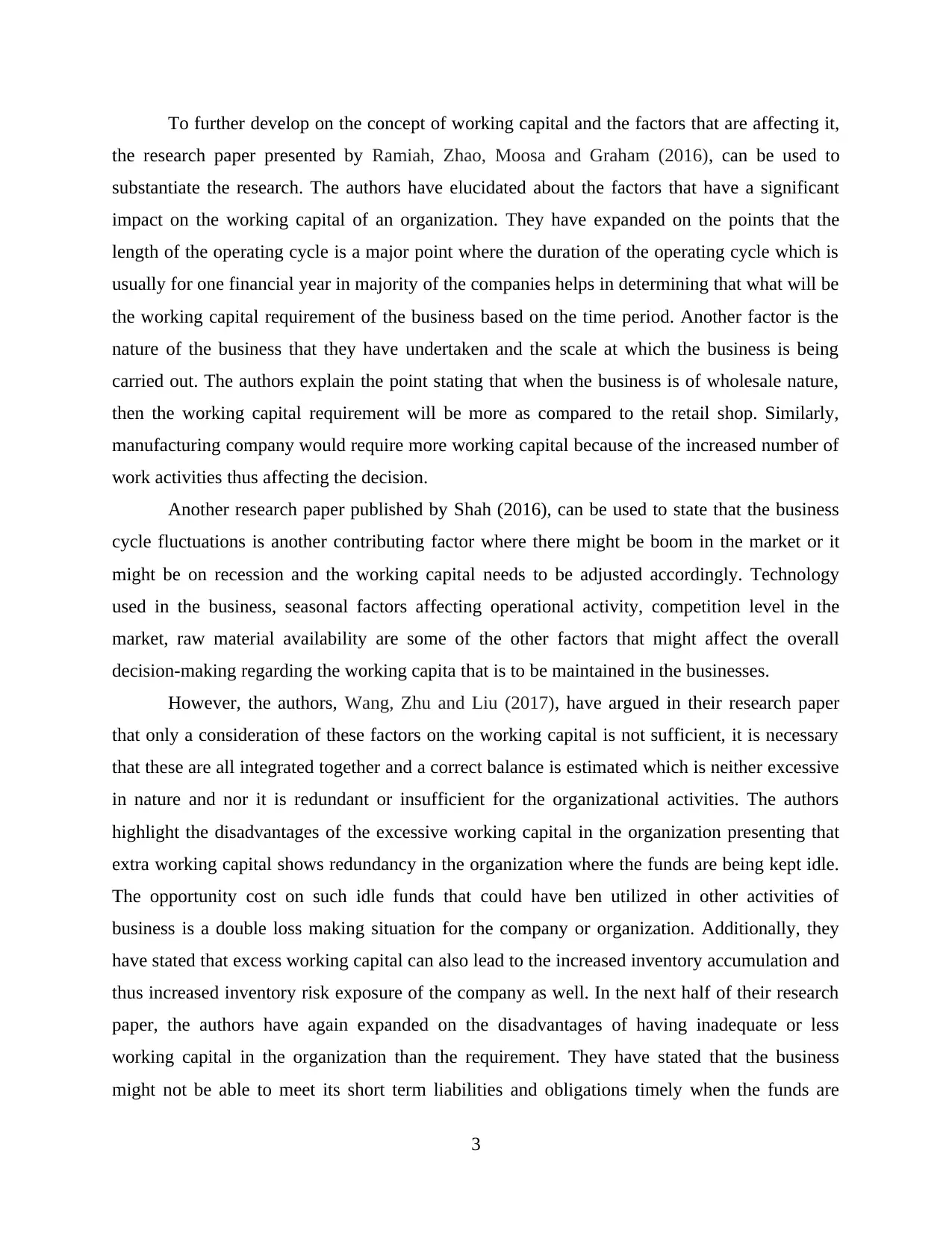
To further develop on the concept of working capital and the factors that are affecting it,
the research paper presented by Ramiah, Zhao, Moosa and Graham (2016), can be used to
substantiate the research. The authors have elucidated about the factors that have a significant
impact on the working capital of an organization. They have expanded on the points that the
length of the operating cycle is a major point where the duration of the operating cycle which is
usually for one financial year in majority of the companies helps in determining that what will be
the working capital requirement of the business based on the time period. Another factor is the
nature of the business that they have undertaken and the scale at which the business is being
carried out. The authors explain the point stating that when the business is of wholesale nature,
then the working capital requirement will be more as compared to the retail shop. Similarly,
manufacturing company would require more working capital because of the increased number of
work activities thus affecting the decision.
Another research paper published by Shah (2016), can be used to state that the business
cycle fluctuations is another contributing factor where there might be boom in the market or it
might be on recession and the working capital needs to be adjusted accordingly. Technology
used in the business, seasonal factors affecting operational activity, competition level in the
market, raw material availability are some of the other factors that might affect the overall
decision-making regarding the working capita that is to be maintained in the businesses.
However, the authors, Wang, Zhu and Liu (2017), have argued in their research paper
that only a consideration of these factors on the working capital is not sufficient, it is necessary
that these are all integrated together and a correct balance is estimated which is neither excessive
in nature and nor it is redundant or insufficient for the organizational activities. The authors
highlight the disadvantages of the excessive working capital in the organization presenting that
extra working capital shows redundancy in the organization where the funds are being kept idle.
The opportunity cost on such idle funds that could have ben utilized in other activities of
business is a double loss making situation for the company or organization. Additionally, they
have stated that excess working capital can also lead to the increased inventory accumulation and
thus increased inventory risk exposure of the company as well. In the next half of their research
paper, the authors have again expanded on the disadvantages of having inadequate or less
working capital in the organization than the requirement. They have stated that the business
might not be able to meet its short term liabilities and obligations timely when the funds are
3
the research paper presented by Ramiah, Zhao, Moosa and Graham (2016), can be used to
substantiate the research. The authors have elucidated about the factors that have a significant
impact on the working capital of an organization. They have expanded on the points that the
length of the operating cycle is a major point where the duration of the operating cycle which is
usually for one financial year in majority of the companies helps in determining that what will be
the working capital requirement of the business based on the time period. Another factor is the
nature of the business that they have undertaken and the scale at which the business is being
carried out. The authors explain the point stating that when the business is of wholesale nature,
then the working capital requirement will be more as compared to the retail shop. Similarly,
manufacturing company would require more working capital because of the increased number of
work activities thus affecting the decision.
Another research paper published by Shah (2016), can be used to state that the business
cycle fluctuations is another contributing factor where there might be boom in the market or it
might be on recession and the working capital needs to be adjusted accordingly. Technology
used in the business, seasonal factors affecting operational activity, competition level in the
market, raw material availability are some of the other factors that might affect the overall
decision-making regarding the working capita that is to be maintained in the businesses.
However, the authors, Wang, Zhu and Liu (2017), have argued in their research paper
that only a consideration of these factors on the working capital is not sufficient, it is necessary
that these are all integrated together and a correct balance is estimated which is neither excessive
in nature and nor it is redundant or insufficient for the organizational activities. The authors
highlight the disadvantages of the excessive working capital in the organization presenting that
extra working capital shows redundancy in the organization where the funds are being kept idle.
The opportunity cost on such idle funds that could have ben utilized in other activities of
business is a double loss making situation for the company or organization. Additionally, they
have stated that excess working capital can also lead to the increased inventory accumulation and
thus increased inventory risk exposure of the company as well. In the next half of their research
paper, the authors have again expanded on the disadvantages of having inadequate or less
working capital in the organization than the requirement. They have stated that the business
might not be able to meet its short term liabilities and obligations timely when the funds are
3
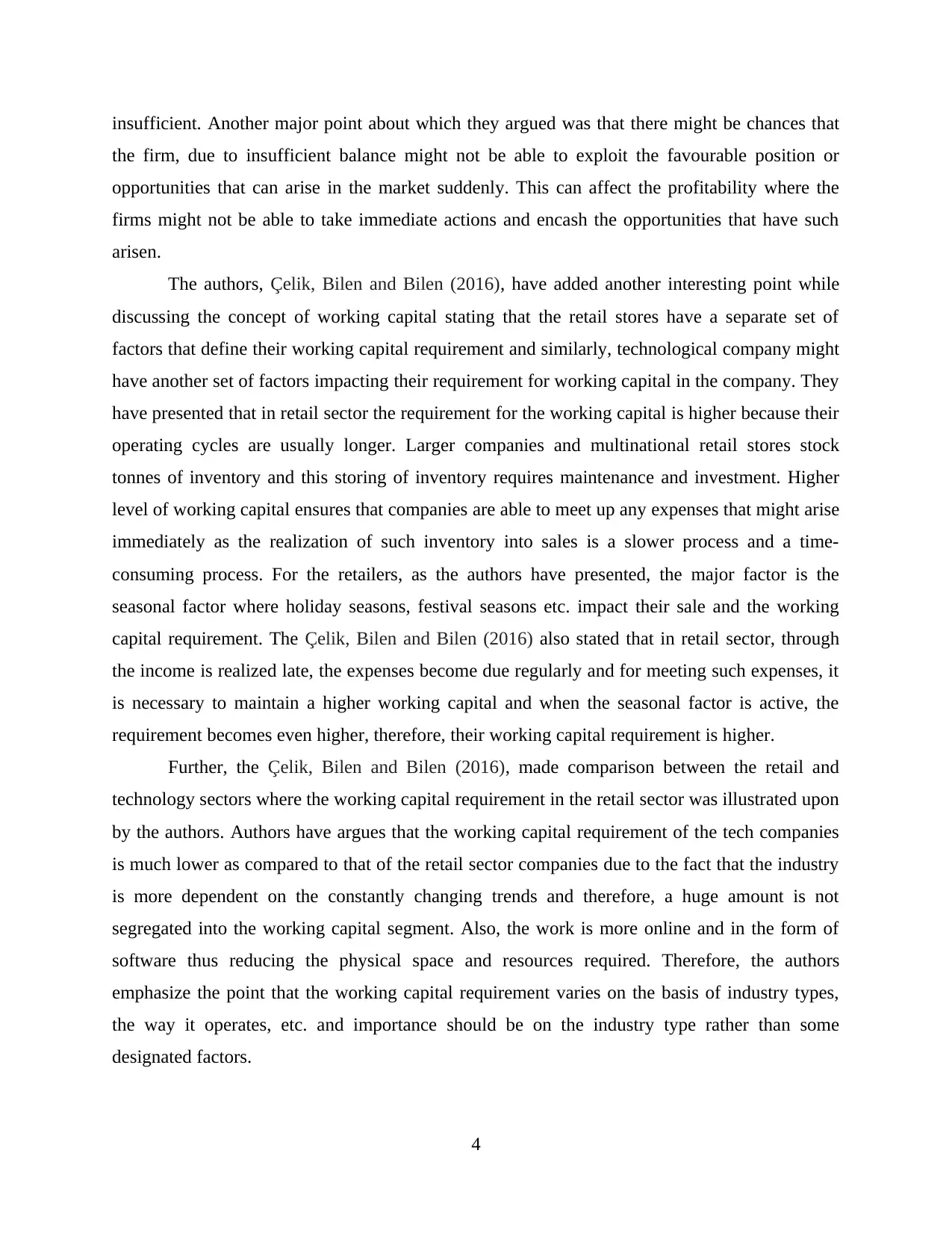
insufficient. Another major point about which they argued was that there might be chances that
the firm, due to insufficient balance might not be able to exploit the favourable position or
opportunities that can arise in the market suddenly. This can affect the profitability where the
firms might not be able to take immediate actions and encash the opportunities that have such
arisen.
The authors, Çelik, Bilen and Bilen (2016), have added another interesting point while
discussing the concept of working capital stating that the retail stores have a separate set of
factors that define their working capital requirement and similarly, technological company might
have another set of factors impacting their requirement for working capital in the company. They
have presented that in retail sector the requirement for the working capital is higher because their
operating cycles are usually longer. Larger companies and multinational retail stores stock
tonnes of inventory and this storing of inventory requires maintenance and investment. Higher
level of working capital ensures that companies are able to meet up any expenses that might arise
immediately as the realization of such inventory into sales is a slower process and a time-
consuming process. For the retailers, as the authors have presented, the major factor is the
seasonal factor where holiday seasons, festival seasons etc. impact their sale and the working
capital requirement. The Çelik, Bilen and Bilen (2016) also stated that in retail sector, through
the income is realized late, the expenses become due regularly and for meeting such expenses, it
is necessary to maintain a higher working capital and when the seasonal factor is active, the
requirement becomes even higher, therefore, their working capital requirement is higher.
Further, the Çelik, Bilen and Bilen (2016), made comparison between the retail and
technology sectors where the working capital requirement in the retail sector was illustrated upon
by the authors. Authors have argues that the working capital requirement of the tech companies
is much lower as compared to that of the retail sector companies due to the fact that the industry
is more dependent on the constantly changing trends and therefore, a huge amount is not
segregated into the working capital segment. Also, the work is more online and in the form of
software thus reducing the physical space and resources required. Therefore, the authors
emphasize the point that the working capital requirement varies on the basis of industry types,
the way it operates, etc. and importance should be on the industry type rather than some
designated factors.
4
the firm, due to insufficient balance might not be able to exploit the favourable position or
opportunities that can arise in the market suddenly. This can affect the profitability where the
firms might not be able to take immediate actions and encash the opportunities that have such
arisen.
The authors, Çelik, Bilen and Bilen (2016), have added another interesting point while
discussing the concept of working capital stating that the retail stores have a separate set of
factors that define their working capital requirement and similarly, technological company might
have another set of factors impacting their requirement for working capital in the company. They
have presented that in retail sector the requirement for the working capital is higher because their
operating cycles are usually longer. Larger companies and multinational retail stores stock
tonnes of inventory and this storing of inventory requires maintenance and investment. Higher
level of working capital ensures that companies are able to meet up any expenses that might arise
immediately as the realization of such inventory into sales is a slower process and a time-
consuming process. For the retailers, as the authors have presented, the major factor is the
seasonal factor where holiday seasons, festival seasons etc. impact their sale and the working
capital requirement. The Çelik, Bilen and Bilen (2016) also stated that in retail sector, through
the income is realized late, the expenses become due regularly and for meeting such expenses, it
is necessary to maintain a higher working capital and when the seasonal factor is active, the
requirement becomes even higher, therefore, their working capital requirement is higher.
Further, the Çelik, Bilen and Bilen (2016), made comparison between the retail and
technology sectors where the working capital requirement in the retail sector was illustrated upon
by the authors. Authors have argues that the working capital requirement of the tech companies
is much lower as compared to that of the retail sector companies due to the fact that the industry
is more dependent on the constantly changing trends and therefore, a huge amount is not
segregated into the working capital segment. Also, the work is more online and in the form of
software thus reducing the physical space and resources required. Therefore, the authors
emphasize the point that the working capital requirement varies on the basis of industry types,
the way it operates, etc. and importance should be on the industry type rather than some
designated factors.
4
⊘ This is a preview!⊘
Do you want full access?
Subscribe today to unlock all pages.

Trusted by 1+ million students worldwide
1 out of 57
Related Documents
Your All-in-One AI-Powered Toolkit for Academic Success.
+13062052269
info@desklib.com
Available 24*7 on WhatsApp / Email
![[object Object]](/_next/static/media/star-bottom.7253800d.svg)
Unlock your academic potential
Copyright © 2020–2025 A2Z Services. All Rights Reserved. Developed and managed by ZUCOL.





